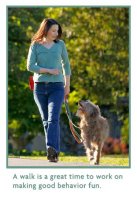Top 10 dog training tips
Have you ever gone to a dog training class or taken a private lesson and left with your head swimming? With so much information, the main messages can sometimes get lost among the more intricate details. Here are some take-home messages that I use to guide my every-day interaction with my patients as well as my own pets.

1. Every interaction you have with the animal is a training session. So it’s important to be aware of what you may be doing to reward inappropriate behaviors throughout the day especially when you are not having planned training sessions.
2. Animals care about your body language and actions more than your words. Consequently, you should focus on the messages your body is giving, pay attention to your pet’s response, and cut down on the words you use.
3. Animals perform behaviors that have been reinforced. In order to change behavior it’s important to reinforce desired behaviors, but we also have to remove reinforcers or motivators for unwanted behaviors.
4. Training is a skill like playing tennis, dancing or playing the piano. Little variations in how you move and on the timing of the movements and rewards make a big difference in whether you can communicate your intentions to your pet. If you’re not getting good results, find someone who can better instruct you on the intricacies of making the change.
5. Positive reinforcement is not just about giving treats for good behavior, it’s about moving and performing the exercises in a manner and speed that make it fun. It’s also about using everything your pet likes or wants, to your advantage—toys, petting, attention, access to go outside or come in, fetch….. and more.
6. The goal of training is to make behaving well fun for the pet. Dogs are more likely to behave well when good behavior is fun.
7. The walk is not a time for your dog to blow you off and do his own thing, rather it’s a time for you to bond with your dog and have fun. Practice exercises during your walk where your dog focuses on you as if you’re playing games. The goal is that the walk becomes like an enjoyable conversation.
8. Dogs, cats, horses and other pets need exercise every day. For dogs, walks provide not only exercise but they are crucial for continued socialization to people, new environments, and other pets.
9. Throw your dog’s food bowl away. Animals in the wild spend hours searching for food. They are hardwired to enjoy this behavior and studies show that given a choice, all species studied prefer to work for their food once they know how to rather than getting it for free. The best way to use food as entertainment and enrichment for the pet is to use it in training and games when you’re home as this provides both food and structured interactions with you. You can also place food in toys and puzzles made specifically for such purposes of entertaining your pet.
10. Make sure your pet is healthy and on a balanced diet. Dogs should have annual veterinary check-ups. For information on balanced diets, visit the American Society of Veterinary Nutritionists at
Related posts:

 Training your dog to do advanced tricks like finding something or bringing their food bowl can be done with just 10 minutes a day and some clicker training. It’s…
Training your dog to do advanced tricks like finding something or bringing their food bowl can be done with just 10 minutes a day and some clicker training. It’s… 6 Principles of Successful Training 1. Be Consistent: Apply the same rules and the same words all the time. 2. Be Concise: Give your command just once. Repetition…
6 Principles of Successful Training 1. Be Consistent: Apply the same rules and the same words all the time. 2. Be Concise: Give your command just once. Repetition… Cesar Millan Cesar is a best-selling author, public speaker, and internationally acclaimed star of the TV shows “Dog Whisperer with Cesar Millan, ” “Leader of the…
Cesar Millan Cesar is a best-selling author, public speaker, and internationally acclaimed star of the TV shows “Dog Whisperer with Cesar Millan, ” “Leader of the… At Monument Dog Training, we believe that change is always possible . We regularly resolve aggressive behavioral issues, even with dogs who have been written off…
At Monument Dog Training, we believe that change is always possible . We regularly resolve aggressive behavioral issues, even with dogs who have been written off… After years of working with thousands of dogs and their owners, I have seen that the key ingredient people are actually looking for is how to be the Pack Leader…
After years of working with thousands of dogs and their owners, I have seen that the key ingredient people are actually looking for is how to be the Pack Leader…